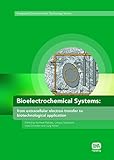Bioelectrochemical systems from extracellular electron transfer to biotechnological application edited by Korneel Rabaey, ... [et al.]
Tipo de material: Libro
impreso(a)
Idioma: Inglés Series Detalles de publicación: London IWA Publishing 2010Descripción: xxxii, 488 páginas ilustraciones 24 centímetrosISBN:
Libro
impreso(a)
Idioma: Inglés Series Detalles de publicación: London IWA Publishing 2010Descripción: xxxii, 488 páginas ilustraciones 24 centímetrosISBN: - 184339233X
- 9781843392330
- 660.62 B5
Incluye bibliografía e índice: páginas 468-488
In the context of wastewater treatment, Bioelectrochemical Systems (BESs) have gained considerable interest in the past few years, and several BES processes are on the brink of application to this area. This book, written by a large number of world experts in the different sub-topics, describes the different aspects and processes relevant to their development. Bioelectrochemical Systems (BESs) use micro-organisms to catalyze an oxidation and/or reduction reaction at an anodic and cathodic electrode respectively. Briefly, at an anode oxidation of organic and inorganic electron donors can occur. Prime examples of such electron donors are waste organics and sulfides. At the cathode, an electron acceptor such as oxygen or nitrate can be reduced. The anode and the cathode are connected through an electrical circuit. If electrical power is harvested from this circuit, the system is called a Microbial Fuel Cell; if electrical power is invested, the system is called a Microbial Electrolysis Cell. The overall framework of bio-energy and bio-fuels is discussed. A number of chapters discuss the basics - microbiology, microbial ecology, electrochemistry, technology and materials development. The book continues by highlighting the plurality of processes based on BES technology already in existence, going from wastewater based reactors to sediment based bio-batteries. The integration of BESs into existing water or process lines is discussed. Finally, an outlook is provided of how BES will fit within the emerging biorefinery area. Inglés


